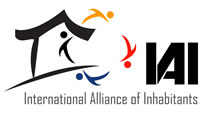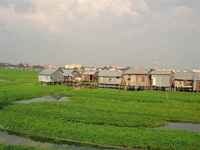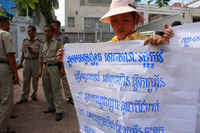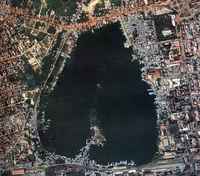Cambodia: Newest Evacuation ‘Biggest in Decades’
PHNOM PENH, Aug 28 (IPS) - Dozens of families this week started dismantling their homes and moving away from lakeside land in the centre of the capital after giving up on their lengthy struggle to remain. By the end of the eviction process at this site, around 30,000 people will have been moved off now-valuable land.
Human rights workers said it will be the biggest movement of Cambodians from their homes in decades.
Residents do not want to leave, but said they are being driven out by threats from the municipality. Some have not given up yet.
Sixty-seven-year-old Pol Vanna has lived at Village Four at the city centre site, called Boeung Kak, since the early 1980s. The former railwayman is adamantly opposed to moving to the relocation site – a field with no facilities some 30 kilometres away.
"We don’t want to leave Boeung Kak," he told IPS during a small demonstration outside City Hall earlier this month. "The company should give us some land for us to live on instead of forcing us to move away. I don’t understand why they can’t give us the land."
The company in question is Shukaku, which reportedly belongs to Senator Lau Meng Khin from the ruling Cambodian People’s Party. His firm received a 99-year lease from the government last year in a typically opaque land deal. Since then, it has been pumping huge amounts of sand into the lake in order to fill it and create more land on which to build.
Evictions are nothing new in Cambodia. At least 100,000 people have been evicted from sites in this capital alone since 2001. The problem is widespread in rural areas, too. The rocketing price of land means there are huge profits to be made, says Naly Pilorge, the director of local human rights group LICADHO, or the Cambodian League for the Promotion and Defense of Human Rights. She said greed and impunity are driving the problem.
The number of people affected nationwide is not clear. Amnesty International said last year that 150,000 were at risk of eviction. LICADHO, which operates in 13 of the country’s 24 provinces, says the numbers of land grabs, evictions and threatened evictions reported to its staff have climbed from around 2,600 cases in 2003 to more than 16,000 in 2008.
Pilorge said that equates to more than a quarter of a million Cambodians in just six years. The true number is certainly higher, she added. "I bet you anything if we had twice as many (staff), we would have twice as many cases."
Uprooting people and relocating them to distant sites where there is no work and few facilities is hardly conducive to poverty alleviation even if that is a stated key concern of government. Pilorge said many evictees at relocation sites outside the capital have been pushed below the poverty line.
One such group of residents was violently evicted in January from a city centre site called Dey Krahorm, which means ‘Red Earth’. There were two broad categories of people at Dey Krahorm: Those who could show they had a legal right to their land because they had lived there for an extended period, and those who were renting.
The evictees from Dey Krahorm were taken to a site called Damnak Trayeung, located outside Phnom Penh. Those who had an entitlement to land at Dey Krahorm received a simple one-room brick home, the size and design of a single garage. Families who were renting received nothing, and are still living under rough tarpaulin lean-tos on a muddy scrap of land next to a road.
There is very little work at Damnak Trayeung. And because the site is more than 20 kilometres from the centre and it would cost a day’s wages to travel to and from work, many people no longer have jobs. According to Licadho, two-thirds of the evictees who used to earn an income now earn nothing.
Luy Sinath is a 41-year-old seamstress who used to earn eight US dollars a day at Dey Krahorm. Now she earns just 25 cents. That means her three children cannot afford to go to school, and her family is no longer self-sufficient. She relies on food handouts from charities to survive.
"We have no food to eat sometimes so people share what we have with each other," she said. "When I was in Dey Krahorm, I was hopeful that my children would get a good education, but now that we are here, I have lost hope."
It is those experiences that worry Pol Vanna and his son, Touris, a 26-year-old construction worker. The latter has visited the proposed relocation site for the evictees from Boeung Kak, which he said lacks any facilities.
"It is very far from the schools for our children and from where we work. Most of us are construction workers," he said. "It is a long way to the nearest hospital. We can’t afford to pay for transportation for our children."
LICADHO’s Naly Pilorge said conditions at some relocation sites outside Phnom Penh are dire, with practically no health care, no schools, no running water, no sanitation, and no jobs. At the Andong relocation site, for example, the human rights group’s doctors go door-to-door because some residents are too ill or old to come to the medics.
"We are seeing malnutrition, beriberi, discolouration of the hair, extended bellies," she said. "They have sores (on their legs) at Andong – these huge infected wounds – because they are constantly walking in stagnant water that is mixed with sewerage."
Back at Boeung Kak, the air is heavy with the sound of hammering as people dismantle homes they have lived in for up to 30 years. They are the first of an estimated 30,000 who will eventually be evicted from the surrounds of the lake.
It is still too early to say how their lives will be affected by the country’s latest dubious land deal. But the experiences of Luy Sinath and others suggest the lives of the people from Boeung Kak will likely get a lot harder in the coming months.
Save Boeung Kak Campaign
Uncensored festival slideshow: Boeung Kak lake
Amnesty International condemns forced evictions in Cambodia



